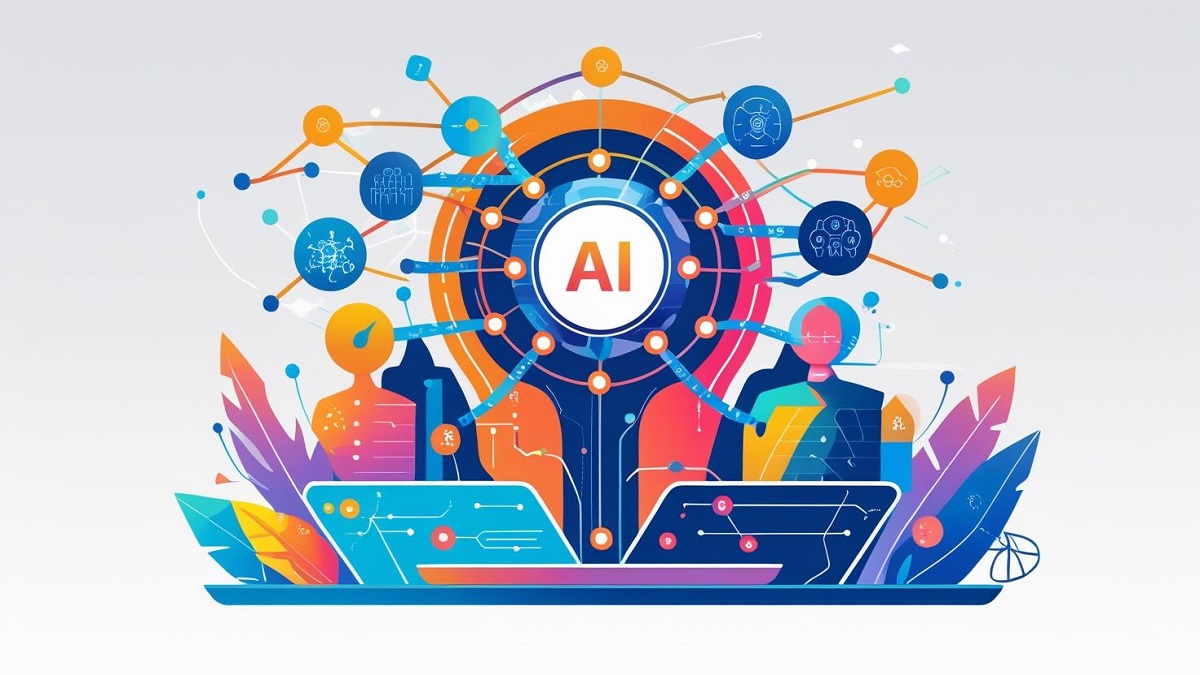In today’s fast-changing tech world, “artificial intelligence” (AI) and “machine learning” (ML) are often mixed up. But are they really the same? As these advanced technologies grow in use across many fields, it’s key to know the main differences between AI and ML. They work together to shape the future of innovation.
Ever wondered how AI and ML differ? And how they can help change your business or field for the better? Explore the basic ideas and practical uses of these powerful tools in this detailed guide.
Key Takeaways
- AI and machine learning are distinct concepts that fall under the same umbrella of intelligent technologies.
- AI is about computers mimicking human thought and actions. ML is a part of AI that uses algorithms to learn from data and predict outcomes.
- Knowing the difference between AI and ML is key to using these technologies for innovation and change in your business or field.
- AI and ML are being used more and more in areas like healthcare, business, and supply chain management. This shows their wide use and impact.
- The future of AI and ML looks bright, with the global AI market size expected to grow a lot in the next few years.
What is Artificial Intelligence (AI)?
Artificial intelligence (AI) is a field that uses technology to make machines think like humans. It includes tasks like reasoning, learning, and solving problems. AI covers many areas, like machine learning, deep learning, and robotics.
AI as an Umbrella Term
AI helps automate tasks and understand data. Artificial Intelligence (AI) and machine learning are often used interchangeably, but machine learning is actually a subset of the broader category of AI. AI works with all kinds of data, but machine learning only uses structured and semi-structured data.
AI systems use logic and decision trees to learn and improve. ML systems use statistical models and can also learn from new data. This means AI can be used in more ways than machine learning.
“Machine learning aims to teach a machine how to perform a specific task and provide accurate results by identifying patterns.”
Companies use AI to automate tasks and understand their data better. AI is key in many technologies, like smart devices and voice assistants. It’s changing industries and making things more efficient.
AI vs Machine Learning: Exploring the Differences
Artificial intelligence (AI) and machine learning (ML) are related but different. AI is about making machines act like humans. ML is a part of AI that uses data to learn and predict.
ML models learn from data and help machines make decisions. AI wants to make machines as smart as humans. ML focuses on specific tasks using data and algorithms.
| Artificial Intelligence (AI) | Machine Learning (ML) |
| AI is the broader concept of creating intelligent machines that can perform human-like tasks. | ML is a subset of AI that involves training algorithms on data to learn and make predictions. |
| AI systems can exhibit human-like behaviors such as learning, problem-solving, and decision-making. | ML models are trained on data to automate specific tasks and make predictions without explicit programming. |
| AI encompasses various techniques and technologies, including machine learning, natural language processing, computer vision, and robotics. | ML algorithms rely on historical data to learn and improve their performance over time without being explicitly programmed. |
| The goal of AI is to create systems that can mimic human intelligence and decision-making. | The goal of ML is to develop algorithms that can learn from data and make accurate predictions or decisions. |
In summary, AI and ML are connected but different. AI is about making machines act like humans. ML uses data and algorithms for specific tasks.
“Machine learning is the field of study that gives computers the ability to learn without being explicitly programmed.”
– Arthur Samuel, Pioneer of Machine Learning
How Machine Learning Operates
Machine learning is changing the world, one industry at a time. It uses advanced algorithms to find patterns in big data. These algorithms get better with more data, making them great at tasks like recognizing images or understanding language.
The Power of Algorithms and Data
Machine learning finds insights in data, not just following rules. It uses algorithms like neural networks and decision trees. For instance, decision trees help predict numbers and sort data into groups.
There are three main types of machine learning: supervised, unsupervised, and semi-supervised. Supervised learning uses labeled data, while unsupervised finds patterns in unlabeled data. Reinforcement learning, like IBM Watson’s Jeopardy win, learns through trial and error.
A 2020 Deloitte survey found 67% of companies use machine learning. And 97% are either using it or planning to. This shows how machine learning is changing industries for the better.
AI vs Machine Learning, AI basics, Introduction to machine learning
Artificial intelligence (AI) and machine learning (ML) are at the center of today’s tech world. They are not the same, but they work together to change how we do things. They are making big impacts in many areas.
AI started in 1956 with John McCarthy’s idea of making machines smart like us. It includes things like understanding language, seeing pictures, making choices, and solving problems. ML, introduced by IBM’s Arthur Samuel in 1952, is a way for machines to get smarter by learning from data.
AI aims to make systems that can do many complex tasks. ML helps these systems get better over time by learning from data. AI uses all kinds of data, while ML needs lots of data to get better.
| AI | Machine Learning |
| Broad field of creating intelligent systems | Specific approach within AI that focuses on learning from data |
| Can work with structured, semi-structured, and unstructured data | Requires large amounts of structured data to learn and improve |
| Key applications: Robotics, natural language processing, speech recognition, autonomous vehicles | Common uses: Pattern recognition, predictive modeling, decision-making in marketing, fraud detection, credit scoring |
The AI market is expected to hit $1.8 trillion by 2030. Knowing about AI and ML is key for businesses and people. These technologies can make things more efficient, personalized, and innovative. They are changing industries and our digital world.
“The real power of machine learning happens when you combine it with human ingenuity.” – Andrew Ng, Co-founder of Coursera and former Chief Scientist at Baidu
Real-World Applications of AI and Machine Learning
Artificial Intelligence (AI) and Machine Learning (ML) are changing many industries. They are making businesses work better and serve customers in new ways. These technologies are used in healthcare, finance, supply chain, and customer service.
Transforming Industries
In healthcare, ML helps analyze big medical data. It aids in making diagnoses and treatment plans. AI chatbots and virtual assistants are also improving customer service everywhere.
In finance, AI stops fraud and keeps customer money safe. It’s a big help in preventing illegal activities.
AI and ML are also changing supply chain management. They help with logistics, forecasting, and making operations smoother. This leads to better efficiency and cost savings.
The uses of AI and ML are growing every day. As these technologies get better, businesses that use them will stay ahead. They will innovate and compete well in their markets.
“AI and machine learning are reshaping the way we live and work, unlocking new possibilities and transforming industries at an unprecedented pace.”
AI and ML are used in many areas, from healthcare to finance and supply chain. They help automate tasks, boost productivity, and solve tough problems. These technologies are making a big difference in how businesses operate.
Deep Learning: A Subset of Machine Learning
In the world of artificial intelligence, deep learning is a key part of machine learning. Machine learning uses algorithms to analyze data and predict outcomes. Deep learning goes further by using artificial neural networks with many layers to solve complex tasks.
Deep learning models can learn and get better on their own from big datasets. They can spot detailed patterns, find important features, and make accurate decisions. This helps in areas like computer vision, natural language processing, and speech recognition.
Unlike traditional machine learning, deep learning models don’t need as much human help. They can learn and adapt by themselves. This is because they have many hidden layers in their neural networks. These layers help the model understand the data in more abstract ways.
| Comparison | Machine Learning | Deep Learning |
| Data Requirements | Can train on smaller data sets | Requires large amounts of data for training |
| Training Time | Shorter training times | Longer training times |
| Accuracy | Lower accuracy | Higher accuracy |
| Human Intervention | Requires more human guidance | Learns autonomously with less human intervention |
| Hardware Requirements | Can train on a CPU | Requires a specialized GPU for training |
| Correlation Identification | Makes simple, linear correlations | Makes non-linear, complex correlations |
The need for smarter solutions is growing fast. Deep learning is playing a big role in this. It can handle huge amounts of data and solve tough problems in many fields. Deep learning is set to change the future of artificial intelligence.
While deep learning and machine learning are related, knowing the differences is key. By using the best of both, companies can make big strides in artificial intelligence. This opens up new possibilities and drives progress in the field.
Challenges and Limitations of AI and Machine Learning
AI and machine learning have changed many industries, making our lives and work better. But, these new technologies also have big challenges and limits. One big worry is bias and lack of clearness in AI choices. Machine learning models, based on lots of data, can pick up and spread biases, causing problems.
Another big issue is keeping data safe and private. AI and machine learning need lots of data to work well. This raises big questions about keeping personal info safe. It’s hard to understand how AI makes choices, which raises ethical questions.
Addressing Ethical Concerns
To tackle these problems, we need everyone to work together. We need strong rules and guidelines for using AI and machine learning. This means making sure AI doesn’t have biases, keeping data safe, and making AI choices clear and fair.
- Make sure AI and machine learning models are tested well to find and fix biases.
- Create AI systems that explain their choices clearly.
- Improve how we keep data safe and private in AI and machine learning.
- Work together to make rules for using these technologies responsibly.
As the challenges of AI and machine learning, limitations of AI and ML, and ethical concerns in AI and machine learning grow, solving these issues is key. This will help these powerful technologies grow in a good way.
“The rise of artificial intelligence and machine learning presents both exciting opportunities and critical challenges that must be carefully navigated.”
The Future of AI and Machine Learning
Artificial intelligence (AI) and machine learning (ML) are changing our lives and industries fast. The global AI market is expected to grow from $136.6 billion in 2022 to $1.8 trillion by 2030. This growth is driven by more use in different areas.
Generative AI, AI in everyday products, and better natural language processing are key trends. These advancements are also changing how we make decisions and predict outcomes. They are making a big impact on how we live and work.
Deep learning, a part of machine learning, is making huge strides. It has beaten humans in tasks like image recognition and medical diagnostics. Geoff Hinton’s work on training neural networks has been crucial. It has opened doors for AI use in many industries.
With 2.5 quintillion bytes of data created daily, AI and ML solutions are in high demand. The machine learning market is set to grow to nearly $226 billion by 2030. This shows the huge potential of these technologies.
But, there are challenges ahead. Ensuring data is unbiased and accurate is key. There’s also the need for resources, dealing with data complexities, and avoiding biased results. As AI and ML get more advanced, ethics will play a big role in their development.
Despite these hurdles, the future of AI and ML looks bright. These technologies will keep changing industries and improving our lives. The next few years will be exciting as AI and ML continue to evolve.
“The future of AI and machine learning is full of possibilities, and we’re only just beginning to scratch the surface of what these technologies can achieve.”
Conclusion
The connection between artificial intelligence (AI) and machine learning (ML) is complex and always changing. AI aims to make machines as smart as humans. ML is a way to do this by training algorithms on data. It helps machines perform tasks and predict outcomes.
Knowing the differences and uses of these technologies is key. This is true for both businesses and individuals wanting to use them well.
In this article, we covered the basics of AI and ML. We talked about different learning methods and their uses. These include spam filtering, product suggestions, and facial recognition.
As AI and ML get better, they will change our lives and work more. This is clear from their growing importance.
The main points from our look at AI vs. ML are clear. They are related but different, and understanding them is crucial. By keeping up with new AI and ML trends, we can use them to innovate, work better, and solve big problems.
FAQ
What is the difference between Artificial Intelligence (AI) and Machine Learning (ML)?
Artificial intelligence (AI) is when computers think like humans and do tasks. Machine learning (ML) is a part of AI. It uses algorithms to learn from data and guess what will happen next.
What are the key applications of AI and machine learning?
AI and machine learning change how businesses work and serve customers. They’re used in healthcare, finance, managing supplies, and helping customers.
How does machine learning work?
Machine learning uses algorithms to find patterns in data and guess what will happen. These algorithms get better with time, without needing to be told what to do.
What is deep learning, and how does it differ from traditional machine learning?
Deep learning is a part of machine learning that uses complex neural networks. These networks can learn and decide on their own. They help with things like seeing pictures, understanding language, and recognizing speech.
What are some of the challenges and limitations of AI and machine learning?
AI and machine learning face issues like bias and not being clear about how they decide things. There are also concerns about privacy and how complex these systems are. It’s important to develop and use these technologies responsibly.
What are the future trends in AI and machine learning?
The future of AI and ML looks exciting. We’ll see more generative AI, AI in everyday products, and big steps in understanding language and seeing images. AI will also help make predictions and decisions.








